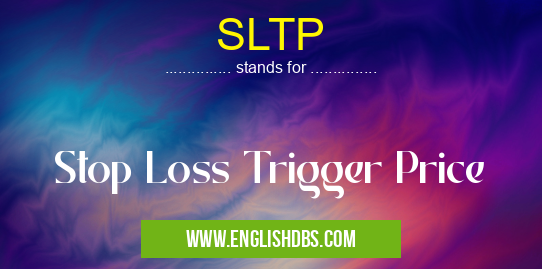What does SLTP mean in UNCLASSIFIED
SLTP stands for Stop Loss Trigger Price. It is a key concept in the financial trading world, particularly in the realm of risk management.

SLTP meaning in Unclassified in Miscellaneous
SLTP mostly used in an acronym Unclassified in Category Miscellaneous that means Stop Loss Trigger Price
Shorthand: SLTP,
Full Form: Stop Loss Trigger Price
For more information of "Stop Loss Trigger Price", see the section below.
Definition
SLTP refers to the predetermined price point at which a trader initiates a stop-loss order. A stop-loss order is an automatic instruction given to a broker to sell (or buy) a security once it reaches a specified price level.
Purpose
The primary purpose of setting an SLTP is to limit potential losses incurred in a trade. By establishing a stop-loss order, traders define the maximum amount they are willing to lose on a particular position.
How it Works
When the price of the security falls (or rises) to the SLTP, the stop-loss order is triggered. This triggers the automatic execution of the trade, selling (or buying) the security at the specified price.
Benefits
- Risk Management: SLTPs provide a safety net against excessive losses by limiting the downside risk of a trade.
- Automated Execution: Stop-loss orders automate the trade execution process, ensuring timely action even when the trader is away from the market.
- Emotional Control: SLTPs help traders avoid making impulsive decisions driven by fear or greed during market volatility.
Considerations
- Appropriate Level: Determining the appropriate SLTP is crucial. It should be set at a level that allows the trade to have room to breathe while protecting against significant losses.
- False Triggers: SLTPs can sometimes be triggered prematurely due to temporary price fluctuations. Traders should be aware of this possibility and adjust their SLTPs accordingly.
- Trailing Stop-Loss: Trailing stop-loss orders can be used to dynamically adjust the SLTP as the price of the security moves in a favorable direction, further enhancing risk management.
Essential Questions and Answers on Stop Loss Trigger Price in "MISCELLANEOUS»UNFILED"
What is Stop Loss Trigger Price (SLTP)?
SLTP is a predetermined price level at which a stop-loss order is triggered. When the price of a security reaches or crosses this level, the stop-loss order is executed, automatically selling the security to limit potential losses.
How is SLTP used?
SLTP is used by traders and investors to manage risk and protect their profits. By setting a SLTP, they determine the maximum amount of loss they are willing to accept on a particular trade. If the market moves against their position, the stop-loss order will be triggered, preventing further losses beyond the specified limit.
What are the advantages of using SLTP?
Benefits of using SLTP include:
- Automated execution: It allows traders to set a loss limit without constantly monitoring the market.
- Risk management: It helps limit potential losses by automatically exiting a trade when the price reaches a predefined level.
- Discipline: It enforces discipline in trading by preventing traders from holding losing positions indefinitely.
What are the factors to consider when setting SLTP?
When determining the appropriate SLTP, traders should consider factors such as:
- Market volatility: Higher volatility may require a wider SLTP to avoid premature execution.
- Position size: Larger positions typically require a wider SLTP to mitigate the impact of price fluctuations.
- Risk tolerance: The SLTP should reflect the trader's risk appetite and the amount of loss they are willing to accept.
How does SLTP differ from a stop limit order?
While both SLTP and stop limit orders are used for risk management, they have key differences:
- Execution: SLTP triggers a market order, which is executed immediately at the prevailing market price, while a stop limit order triggers a limit order, which is executed at a specific price or better.
- Price movement: SLTP is triggered when the security's price touches or crosses the specified level, while a stop limit order is triggered when the price touches or crosses the specified level in a specific direction (e.g., below for a sell order).
Final Words: SLTP is an essential tool for managing risk in financial trading. By setting stop-loss trigger prices, traders can protect their capital against adverse price movements. However, it is important to use SLTPs judiciously and in conjunction with other risk management strategies to maximize their effectiveness.
